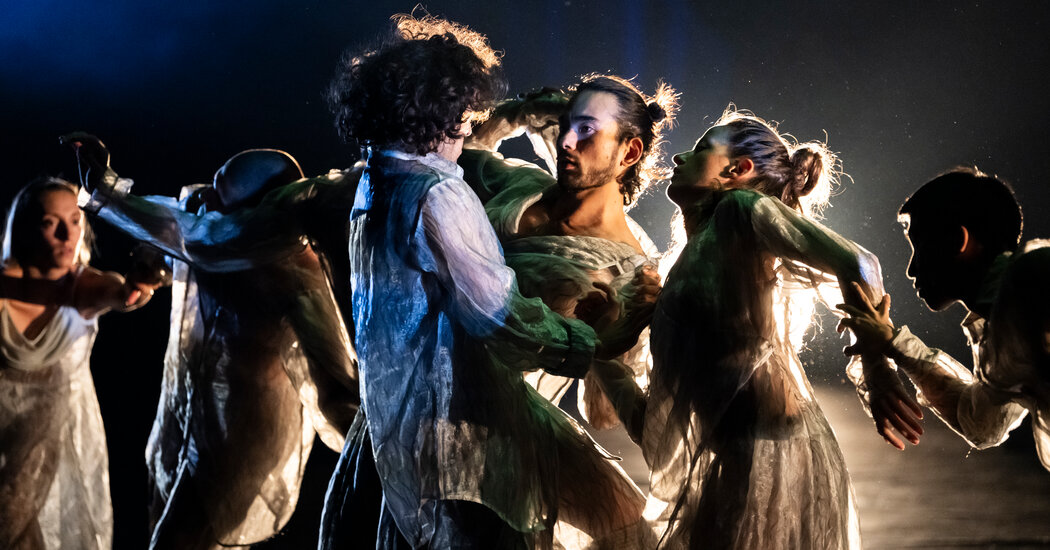
The program featured three living female choreographers but not much in the way of traditional ballet.
The Palais Garnier might have been designed for an extravagant party, its wide stairs created to be bedecked with flowers, its sumptuous gilded framework and ornate statues a perfect backdrop for posing in couture. On Thursday night, the Paris Opera Ballet opened its season with the traditional accouterments of its annual gala: rivers of Champagne, exquisite outfits, teetering heels, botoxed foreheads.
It has been only nine years since the Paris Opera Ballet held its first benefit gala, a strange American-style novelty, perhaps perceived as slightly vulgar for a largely state-subsidized organization. But that gala in 2015, planned by Benjamin Millepied at the start of his short tenure as company director, tapped into the glamour of the Paris Opera in the collective imagination, the possibility for maximum visibility among elite patrons and synergy with luxury brands. (This year, Rolex and Chanel were the lead sponsors.)
It’s anybody’s guess what Thursday’s high-paying audience made of the program, which included two new works, by Marion Motin and Xie Xin, as well as a pièce d’occasion by the company dancer Nicolas Paul, and Crystal Pite’s “The Seasons Canon.” One black-tied representative might have summed it up: “Un peu boring, non?” he said to his companion as he exited.
Since December, the Paris Opera Ballet has been run by José Martinez, who took over six months after the surprise resignation of Aurélie Dupont. He has inherited her programming for this season, and in a program note, he discreetly suggests he might go in a different direction, developing “a choreographic vocabulary using the pointe shoe.”
Dupont wasn’t particularly keen on using the pointe shoe, as evidenced by the commissioned work on this program. Motin comes from the world of hip-hop, Xie from contemporary dance; both are intent on having the dancers develop new physical vocabularies rather than exploit ballet technique. But you have to admire the boldness of Dupont’s gala program statement: three living female choreographers, one the first Chinese dance-maker to create a work here.
Pointe shoes (and tutus) were much in evidence in the opening Defilé du Ballet, a 25-minute ceremonial presentation of the company and the school to Berlioz’s “Marche des Troyens” — a perfect illustration of Paris Opera Ballet’s hierarchical grandeur.
Beginning with the youngest pupil at the school and ending with the most senior of the company’s étoiles, or star dancers, the Defilé was also the farewell of the étoile Émilie Cozette. Breaking with customary formality at the end, she took a solo bow and got hugs from fellow étoiles.
Then came Paul’s “Singularités Plurielles,” a commission from Martinez featuring Amandine Albisson, Valentine Colasante and Hannah O’Neill. This brief trio, to a string and piano quintet by André Caplet, featured pointe shoes but not a great deal of vocabulary as the women, wearing chic, short pink dresses by Chanel, crossed and uncrossed their legs on chairs. Later they changed into chic suits; perhaps a commentary on male-female identity, perhaps just a chance for more Chanel costuming.
In their own ways, the next two commissions were equally conventional. In “The Last Call,” Motin, who has worked with Christine and the Queens, offers a contemporary “Jeune Homme et la Mort.” It opens with a phone ringing in a call box on an empty stage. A man in jeans (Alexandre Boccara) walks on to answer it. The caller is Death (Axel Ibot), sporting black latex.
Then follows a not-unenjoyable 25 minutes in which rubber-clad angels initiate the man into their group, while Death dances along. It is essentially a long music video, without the edits and with really good dancers. There is smoke and cigarette smoking; hard-driving music by Micka Luna; lots of low-to-the-ground, hip-thrusting bodies pumping in unison; and a jazzy nightclub scene with shades of Bob Fosse. The costumes (by Arthur Avellano) were sexy, the dancers seemed to have fun and Death did not appear to triumph. At the end Boccara strolled offstage.
Xie’s “Horizon” was a complete contrast, a meandering, nebulous work that had nine dancers curving with soft, fluid swirls through a landscape of waist-high billowing mist. The imagery evokes nature, life and death — the dancers keep disappearing into the fog, then re-emerging — and the movement quality is interesting. Xie works against ballet’s pulled-up positions and tensions of line and extension, so that the dancers appear part of a greater flow of motion, subject to breath and gravity.
But the piece is wildly dull, set to anodyne music by Sylvian Wang that alternately evokes soothing sounds at a high-end spa and film-score mood setting. Nothing is helped by lighting (by Gao Jie) that goes from dark to extremely dark, or the mist that masks (at least from the stalls) a good portion of the dancers’ bodies.
After all of this, I liked Pite’s “The Seasons Canon” a lot more than at its 2016 premiere. The piece, for 54 dancers, expertly forms and dissolves huge groupings with acute musicality and undeniable theatricality. You could feel the audience’s relief in the wild applause. Culture done. On to dinner!






